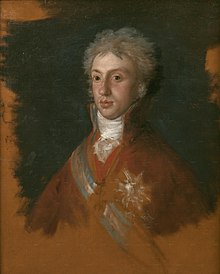Louis I(Italian:Ludovico I;5 July 1773 – 27 May 1803) was the first of the twokings of Etruria.Louis was the son ofFerdinand, Duke of Parma,andMaria Amalia of Austria.He was born in 1773, when his great-grandfather, KingLouis XVof France, was still alive.
| Louis I | |||||
|---|---|---|---|---|---|
 Portrait byGoya,1800 | |||||
| King of Etruria | |||||
| Reign | 21 March 1801 – 27 May 1803 | ||||
| Predecessor | Ferdinand IIIas Grand Duke of Tuscany | ||||
| Successor | Louis II | ||||
| Born | 5 July 1773 Piacenza,Duchy of Parma | ||||
| Died | 27 May 1803(aged 29) Florence,Kingdom of Etruria | ||||
| Burial | |||||
| Consort | Maria Luisa of Spain | ||||
| Issue | Charles II, Duke of Parma Maria Luisa Carlota, Hereditary Princess of Saxony | ||||
| |||||
| House | Bourbon-Parma | ||||
| Father | Ferdinand, Duke of Parma | ||||
| Mother | Maria Amalia of Austria | ||||
| Religion | Roman Catholicism | ||||
Early life
editLouis Francis Philibert (Italian:Ludovico Francesco Filiberto) was the second child and eldest son of Ferdinand, Duke of Parma, a grandson of French King Louis XV and Marie Leczinska, and his wifeArchduchessMaria Amalia of Austria. Louis and his older sisterCarolinawere the favorites of their parents. They were personally instructed in religion by their father, despite the fact that their younger children was actually more interested in the subject than they were.[1]In 1778, he hit his head on a marble table while playing with Carolina, and afterward suffered from epilepsy.[1]
Marriage and issue
editIn 1795, Louis came to the Spanish court to finish his education and also to marry one of the daughters of KingCharles IV of Spain,who were his first cousins. He was to marry InfantaMaria Amaliaor InfantaMaria Luisa,and chose the latter, who was somewhat more attractive and cheerful than the melancholy Maria Amalia. On 25 August 1795, he married Maria Luisa atMadridand was made anInfanteofSpain.
The marriage between the two different personalities turned out to be happy, though it was clouded by Louis's ill health. He was frail, suffered chest problems, and since a childhood accident when he hit his head on a marble table, suffered from symptoms that have been identified as epileptic fits. As the years went on, his health deteriorated, and he grew to be increasingly dependent on his wife. The young couple remained in Spain during the early years of their marriage.
The couple had two children:
- Charles Louis Ferdinand(1799–1883)
- Maria Luisa Carlota,Hereditary Princess of Saxony (1802–1857), married to HereditaryPrince Maximilian of Saxony,widower of her auntCaroline,as his second wife and remained childless.
Swap of Parma and Etruria
editWhile Louis was staying in Spain, theDuchy of Parmahad been occupied by French troops in 1796.Napoleon Bonaparte,who had conquered most of Italy and wanted to gain Spain as an ally against England, proposed to compensate theHouse of Bourbonfor their loss of the Duchy of Parma with theKingdom of Etruria,a new state that he created from theGrand Duchy of Tuscany.This was agreed upon in theTreaty of Aranjuez.
Louis had to receive his investiture from Napoleon in Paris, before taking possession of Etruria. Louis, his wife and his son travelled incognito through France under the name of the Count of Livorno. Having been invested in Paris as King of Etruria, Louis and his family arrived in August 1801 at his new capital, Florence.
In 1802, both Louis and his pregnant wife travelled to Spain to attend the double-wedding of Maria Luisa's brotherFerdinandand her youngest sisterMaria Isabel.Offshore at Barcelona, Maria Luisa gave birth to their daughter, Marie Louise Charlotte. The couple returned in December of that year, after having been notified of the death of Louis's father.
Back in Etruria, Louis's health worsened, and in May 1803, he died at the age of twenty-nine, possibly due to an epileptic crisis. He was succeeded by his son,Charles Louis,as King Louis II of Etruria, under the regency of his mother, Maria Luisa.
Ancestry
edit| Ancestors of Louis I of Etruria |
|---|
References
editExternal links
edit- Media related toLouis of Etruriaat Wikimedia Commons